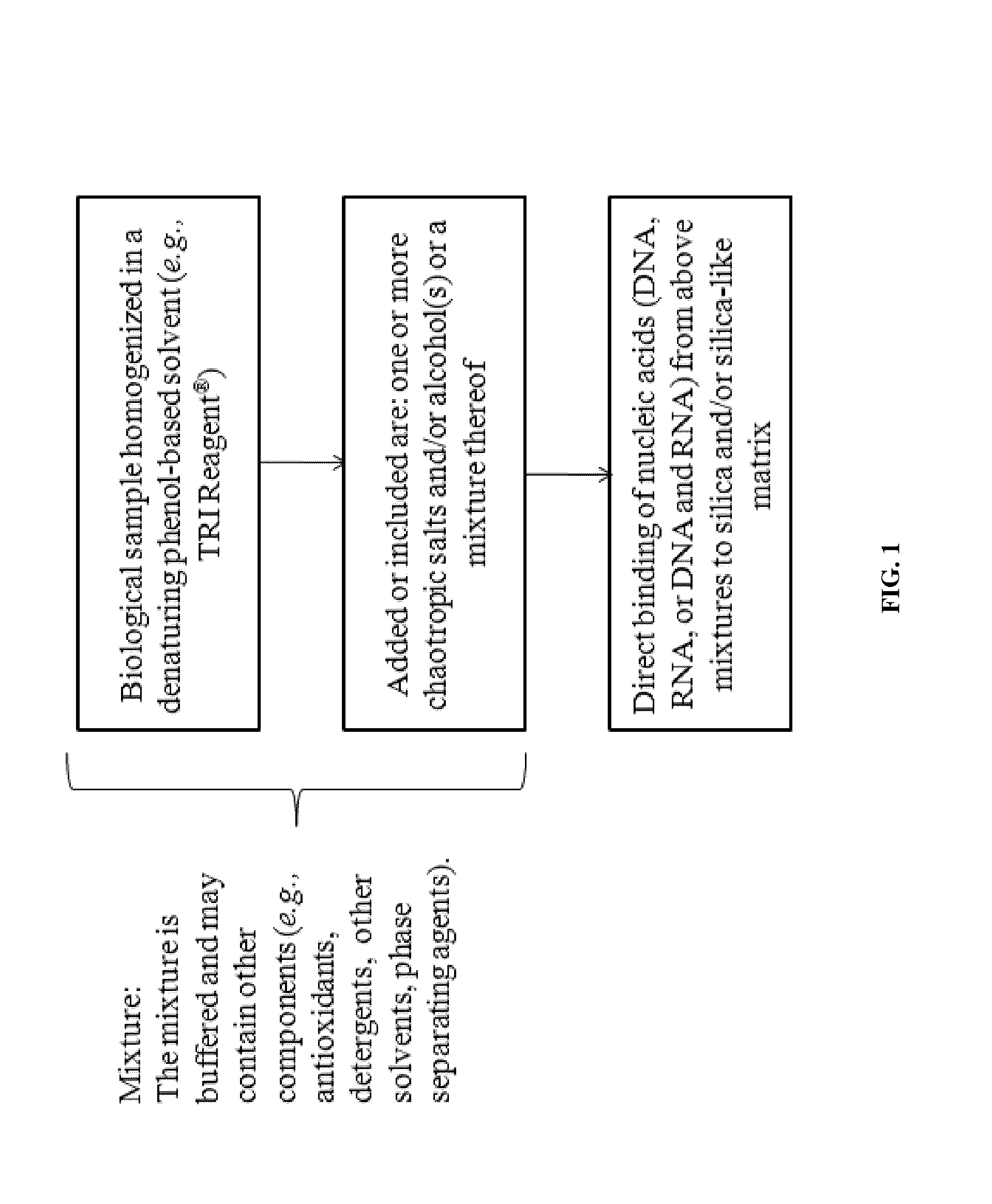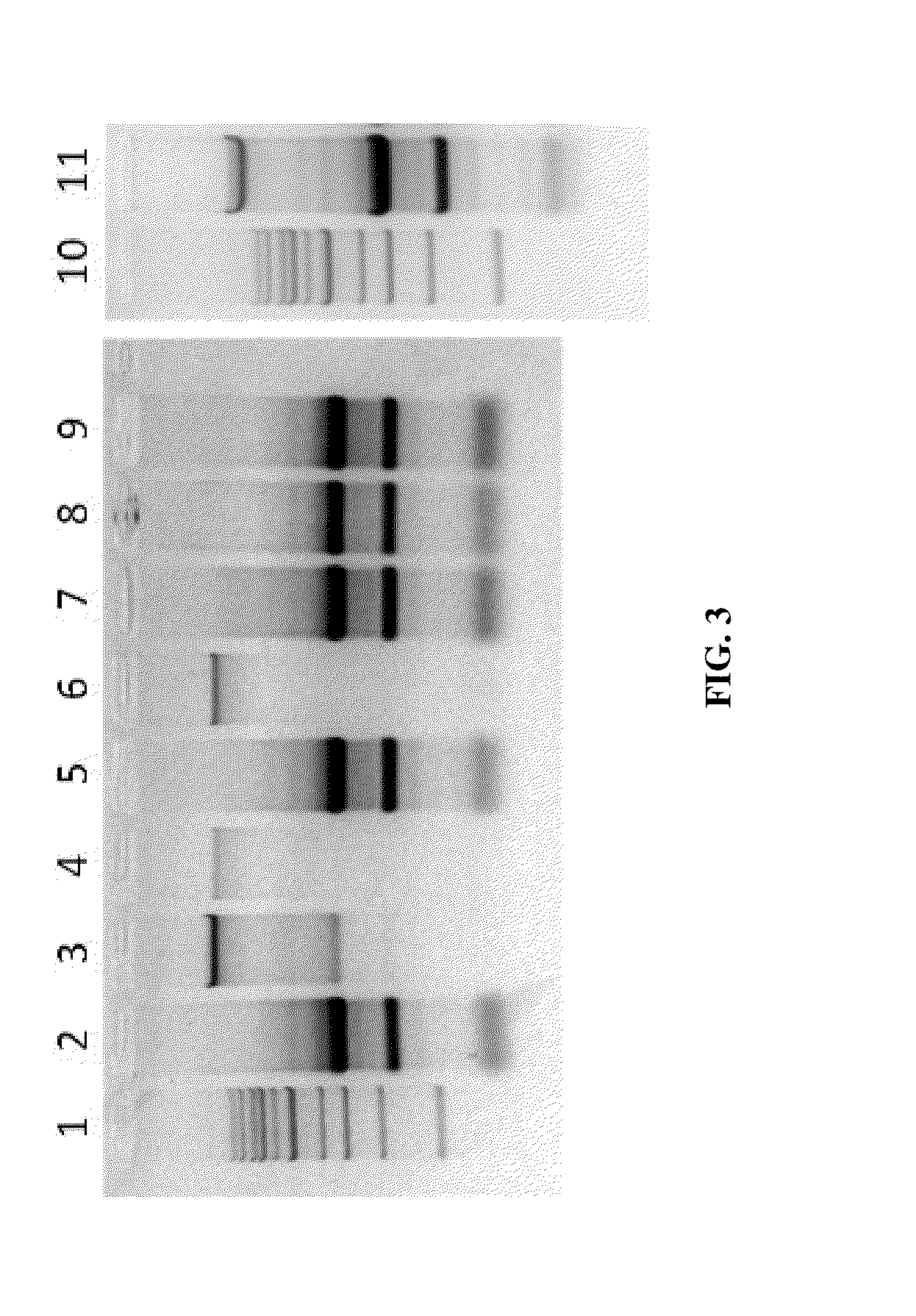Nucleic Acid Purification
a technology of nucleic acid and purification method, applied in the field of biochemistry and molecular biology, can solve the problem that phenol-based reagents must be later carefully removed
- Summary
- Abstract
- Description
- Claims
- Application Information
AI Technical Summary
Benefits of technology
Problems solved by technology
Method used
Image
Examples
example 1
RNA Isolation from Human Cells
[0065]Various techniques were used for purification of RNA from human cells that were frozen at −80° C. RNA was isolated from ˜100,000 frozen human cells resuspended in 50 μl of water. Samples in lanes 2-6 were lysed in 125 μl of RNAzol® and further were added one or more of the following, water, ethanol, isopropanol (indicated as “Treatment” in the Table 1). Samples in lanes 7-10 were lysed in 200 μl TRIreagent® and further were added one or more of the following, chloroform, ethanol, isopropanol (indicated as “Treatment” in the Table 1.). Samples in lanes 2-5 and 7-9 were processed by column purification using a silica matrix. Each suspension mixture including all components as indicated in “Treatment” (Table 1) was loaded onto the Zymo-Spin™ IC column (Zymo Research, Irvine Calif.), centrifuged at 12,000×g, and flow-through discarded. The column was washed once with 700 μl RNA Wash Buffer then centrifuged in an empty collection tube to remove residua...
example 2
DNA and RNA Isolation from Human Cells
[0067]Various techniques were used for purification of nucleic acid molecules from human cells that were frozen at −80° C. Frozen cell samples from ˜50,000 human cells were resuspended in 25 μl of water. All samples (lanes 2-9 and 11) were lysed in 100 μl of TriReagent. Following the lysis, a binding agent was added to the sample as indicated under “Treatment” (Table 2). The mixtures including all components as indicated in “Treatment” (Table 2) were loaded onto the Zymo-Spin™ IC column (Zymo Research, Irvine Calif.), centrifuged at 12,000×g, and flow-through discarded (sample / lane 2-3,5,7-9, 11) or saved for further processing (sample / lane 4 and 6). 95% ethanol was added to the flow-through from samples / lanes 4 and 6 and the mixture was loaded onto the a new Zymo-Spin™ IC column, centrifuged at 12,000×g, and flow-through discarded. After binding, all columns were washed once with 700 μl RNA Wash Buffer then centrifuged in an empty collection tu...
example 3
Automated Nucleic Acid Isolation Using Magnetic Beads
[0069]Isolation of RNA (DNA) from phenol-containing sample lysates, without phase separation, allows for direct binding of nucleic acids to a column matrix or beads, such as magnetic beads, and is ideal for automated sample processing. As an example of such automated processing samples were processed as detailed below the resulting RNA quantified and assess for quality.
[0070]1. 5×105 human epithelial cells were lysed in TRI Reagent and cleared by centrifugation.
[0071]2. Direct-zol™ Binding Buffer (see above) were added to the sample lysate (1:1 ratio) and mixed.
[0072]3. Magnetic silica beads (MagBinding Beads) were then added to the mixture to bind nucleic acids.
[0073]4. Beads are washed by 95-100% ethanol, Direct-zol™ MagBinding Bead PreWash, and 95-100% ethanol again, several times.
[0074]5. Optionally, during the wash steps, DNase I treatment can be performed with provided DNase I / 10× Reaction Buffer.
[0075]6. Beads are dried and...
PUM
| Property | Measurement | Unit |
|---|---|---|
| Fraction | aaaaa | aaaaa |
| Fraction | aaaaa | aaaaa |
| Fraction | aaaaa | aaaaa |
Abstract
Description
Claims
Application Information
 Login to View More
Login to View More - R&D
- Intellectual Property
- Life Sciences
- Materials
- Tech Scout
- Unparalleled Data Quality
- Higher Quality Content
- 60% Fewer Hallucinations
Browse by: Latest US Patents, China's latest patents, Technical Efficacy Thesaurus, Application Domain, Technology Topic, Popular Technical Reports.
© 2025 PatSnap. All rights reserved.Legal|Privacy policy|Modern Slavery Act Transparency Statement|Sitemap|About US| Contact US: help@patsnap.com



